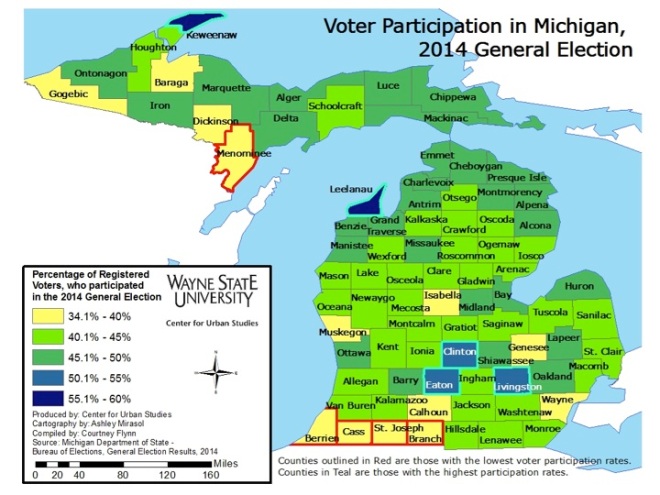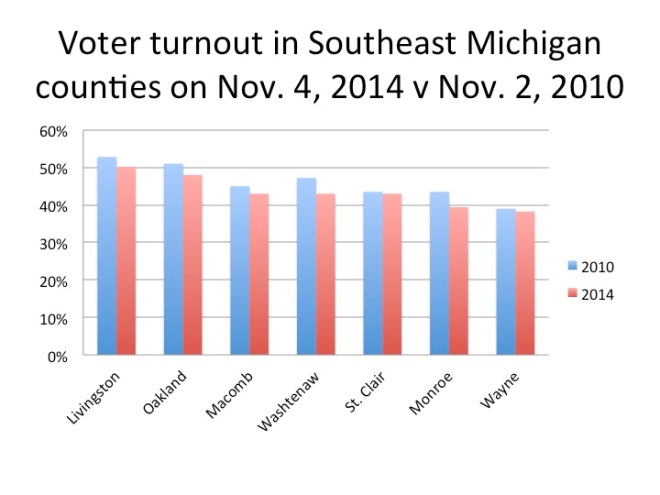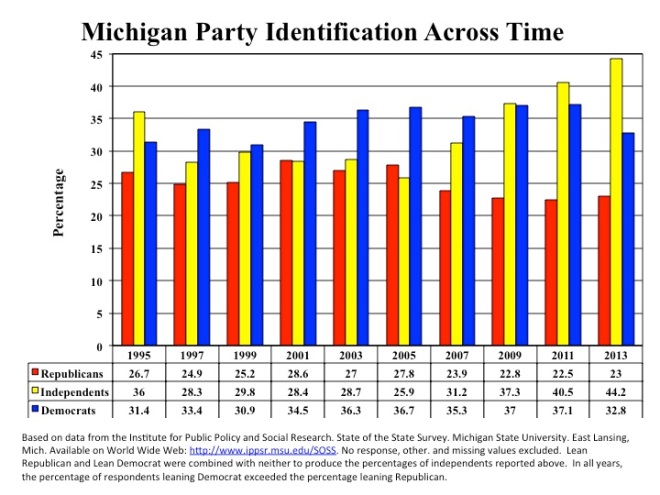Michigan’s voter turnout on Nov. 4, 2014 was the lowest in 24 years–41.6 percent. In 1990, voter turnout was 38.6 percent. Four years ago, during the previous gubernatorial race, turnout was 42.9 percent. Considering the data above, it is clear that more voters turn out during presidential elections than during gubernatorial elections—which, in Michigan, occurs during mid-term election years. Within the last 24 years, the highest voter turnout (50.7%) for a mid-term year was recorded during the 2006 general election, in which Gov. Jennifer Granholm, a Democrat, won a second-term.
Voter turnout in primary elections is even lower than in gubernatorial elections. For example, during this year’s primary election, statewide voter turnout was 17.5 percent. The last time it fell below that was in 2006, when only 16.9 percent of voters turned out in the primary.
As shown in the map (below), though 2014 general election voter turnout for the entire state of Michigan was 41.6 percent, five of the seven counties in Southeast Michigan had a higher voter turnout. Of those seven counties, Livingston County had the highest voter turnout at 50.2 percent, and also one of the highest percentages of turnout in the state.
According to the Michigan Secretary of State, turnout in only five counties exceeded 50 percent. These top five counties are:
Keweenaw – 59.56% Leelanau – 56.52% Clinton – 52.72% Eaton – 50.81% Livingston – 50.26%
Wayne County had the lowest percentage of voters turnout in the Southeast Michigan region for the 2014 general election (39.2%), but it did not make the list of one of the five counties with the lowest voter turnout in 2014 (it did in 2012 though). According to the Michigan Secretary of State, the five Michigan counties with the lowest voter turnout this November were:
Cass – 34.11% Menominee – 34.16% St. Joseph – 34.37% Berrien – 34.95% Branch – 35.94%
As seen in the map below, there were 13 total counties where voter turnout was below 40 percent on Nov. 14, 2014. This map also shows that majority of the state fell in the 40.1 to 45 percent range for voter turnout. In the northern part of the state (particularly the Upper Peninsula and the tip of the Lower Peninsula), the average was in the 45.1 to 50 percent range. Of course there were a few exceptions.
Voter turnout in Wayne County and all the other counties in the Southeast Michigan region was lower than it was in 2010.
For Wayne County, the difference was rather minor, despite the fact the overall voter turnout was low. In 2010, 39 percent of registered voters cast a ballot, compared to the 38.23 percent who voted in 2014, according to records from Michigan Secretary of State.
Monroe County experienced the largest percentage difference. In 2010, 44 percent of registered Monroe County voters cast a ballot and in 2010, 39.4 percent did so—a 4.6 percent difference.
Washtenaw County had the second largest difference: voter turnout was 47 percent in 2010 and 43 percent in 2014, according to the Michigan Secretary of State.
The above chart shows Michigan party identification from 1995-2013. When just comparing Democratic and Republican party identifications, Democrats have maintained an edge over Republicans for nearly two decades. For the decade between 1997 and 2007, Democrats outnumbered Independents as well as Republicans.
In 2013—the most recent non-election year for which data are available—the percentage of registered Michigan voters who identified with the Democratic Party remained higher than those who identified themselves as Republicans. That year, 33 percent of registered voters identified as Democrats; 44 percent identified as Independents, and 23 percent identified as Republicans.
The above chart is based on data from the Institute for Public Policy and Social Research. State of the State Survey. Michigan State University. East Lansing, Mich. Available on Web: http://www.ippsr.msu.edu/SOSS. The variables used were PartyID and sossyr and the data file used is the Longitudinal SOSS Data File. No response, other, and missing values are not included, hence totals do not equal 100%.
Turnout data demonstrate that young voters are among those least likely to vote in mid-term elections. We illustrate this effect in Michigan using Ann Arbor precinct data. (presented below) We have identified the Ann Arbor precincts with an especially high proportion of young, educated voters near the University of Michigan. (These show both the 2012 and 2014 turnout.) Ann Arbor’s precinct-level data reveals that these precincts where large populations of students live had exceptionally low turnout on November 4, 2014. Some of these precincts had 30 percent or more voter turnout in the 2012 presidential election, then had single-digit percent turnout in the 2014 general election. Each of these precincts with high concentrations of students had turnout of less than 15 percent.
There are confounding variables in using these data. Students who registered to vote in the 2012 election may have graduated and moved. But, it should be possible to register new student voters to replace those who have moved away if mobilization efforts are targeted effectively.
In addition to examining the voter turnout near the U of M campus, we explore information from a Web site, CIRCLE, run by Tufts University that reports on research about young voters. According to Tufts, the takeaways related to young voters in this year’s election were:






